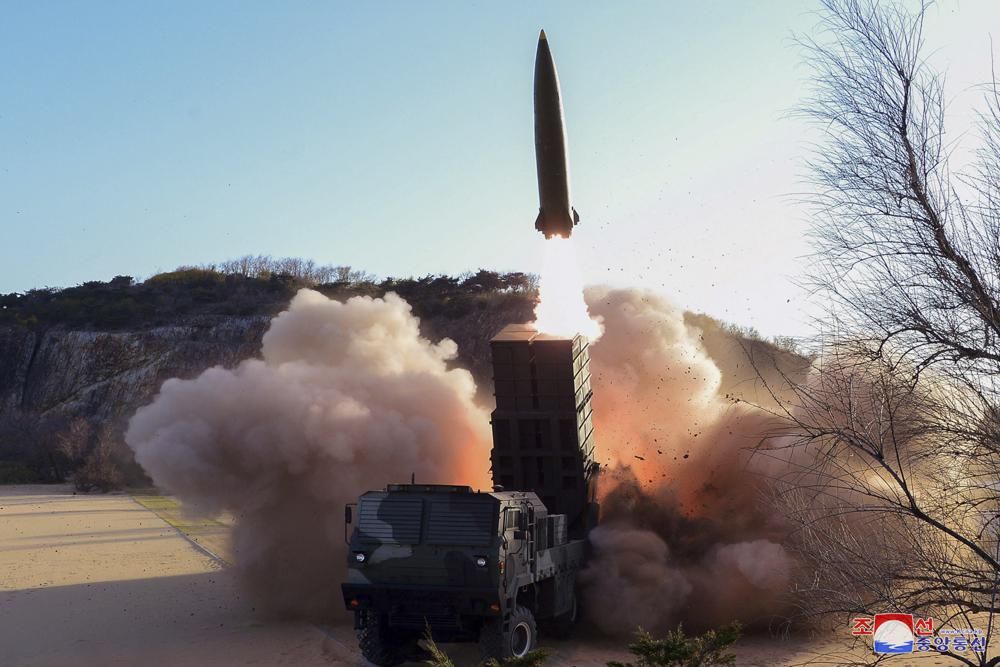Why US policy on North Korea should prioritize nonproliferation, not denuclearization
By Jordan Chase, Eliana Johns | January 13, 2023
 North Korea said it test-launched a newly developed tactical guided weapon from an undisclosed location on April 17, 2022. (Photo released by North Korea's Korean Central News Agency - KCNA).
North Korea said it test-launched a newly developed tactical guided weapon from an undisclosed location on April 17, 2022. (Photo released by North Korea's Korean Central News Agency - KCNA).
While total denuclearization of the Korean Peninsula remains a security objective of the United States, the idea of North Korea relinquishing its nuclear weapons looks increasingly unrealistic. North Korea’s refusal to cooperate diplomatically, increased missile launches near US-allied territory, aggressive rhetoric, and expected seventh nuclear test signify blatant hostility toward disarmament discussions, especially those that demand its complete denuclearization. Given this reality, the United States’ strategic emphasis must shift away from denuclearization.
North Korea’s accelerated nuclearization. Since the dawn of the Atomic Age, policymakers and citizens alike have regarded thermonuclear weapons as the sinister culmination of humanity’s worst tendencies for violence and destruction. Without regard for the humanitarian consequences of developing these weapons, North Korea has emerged in recent years as a prominent threat to the global nonproliferation regime. Despite widespread counterproliferation and disarmament efforts, North Korea has relentlessly pursued nuclearization to facilitate regime survival, legitimacy, and coercive diplomacy. Years of negotiation with the United States and regional parties proved futile when North Korea conducted its first nuclear test in 2006.
This landmark development shifted international attention toward preventing further development of strategic, high-yield thermonuclear weapons and accompanying delivery vehicles. Despite these efforts, North Korean leader Kim Jong-un has since overseen the accelerated production of nuclear warheads, leading to the nation’s sixth, and largest, nuclear test in 2017, with estimates placing the yield over 100 kilotons. Given the current rate of fissile material production, North Korea can likely produce up to 12 new warheads annually depending on the warhead design and existing stockpile of fissile material.
North Korea has dedicated significant resources to developing intercontinental ballistic missiles (ICBMs) to effectively deliver these high-yield weapons globally. Some of these missiles, such as the recently tested Hwasong-17, will likely be capable of housing multiple independently targetable reentry vehicles (also commonly referred to as MIRVs), which dramatically increases the destructive power of a North Korean nuclear attack and reduces the effectiveness of current missile defense systems.
A shift toward tactical nuclear weapons. After years of emphasis on strategic nuclear capabilities, in January 2021, Kim Jong-un declared his intent to develop tactical nuclear weapons. If North Korea can successfully develop, test, and operationalize a smaller nuclear warhead, this would present greater challenges to nuclear security, stability, and nonproliferation than strategic weapons. Although they rarely have the destructive power of strategic nuclear weapons, nuclear warheads designed for potential use in artillery or other short-range delivery vehicles significantly lower the threshold for escalation to nuclear first use. To ensure the effective delivery of these weapons, Kim could delegate launch authority to battlefield commanders positioned to respond to rapidly evolving threat scenarios. While this delegation would be a significant departure from the traditionally centralized North Korean command and control structure, it would be an effective way for Kim to reinforce a credible deterrent and ensure the survival of North Korea’s nuclear system in case of decapitation or if communications were compromised during an attack.
Possible evidence of this strategy can be drawn from the presence of unit commanders at the April 16, 2022 testing of a short-range ballistic missile and the subsequent Korean Central News Agency (KCNA) statement that the missile boosts the country’s frontline long-range artillery units and increases “the operation of tactical nukes and diversification of their firepower missions.” Additionally, on September 8, 2022, Pyongyang codified a new nuclear doctrine and noted for the first time that “in case the command and control system over the state nuclear forces is placed in danger owing to an attack by hostile forces, a nuclear strike shall be launched automatically and immediately” in accordance with an “operation plan decided in advance.” These operational and policy changes could indicate movement towards a first-use nuclear strategy and potentially the implementation of a delegation framework that could be executed in wartime or crisis. If launch authority were delegated, the number of individuals who could decide to deploy a nuclear weapon would multiply, leaving substantial room for miscalculation, misperception, or misuse. This becomes particularly concerning given North Korea’s lack of sophisticated intelligence, surveillance, and reconnaissance capabilities and subsequent lack of strategic situational awareness.
Kim may also believe that comparatively less-damaging tactical nuclear weapons could be deployed without fear of guaranteed retaliation by the United States, whose nuclear deterrent is extended to South Korea. Because North Korea possesses the theoretical capability to strike the continental United States with a strategic nuclear weapon—provided that the missiles aren’t destroyed in the midcourse phase and survive atmospheric reentry—the risk would be far greater for the United States to intervene militarily after North Korean tactical nuclear use. If no major US population centers, troops, or military facilities are targeted, the United States could be reluctant to enter a foreign conflict that puts its mainland at risk of a nuclear attack. Escalation from conventional conflict to nuclear first use through a preemptive or retaliatory strike on South Korean ports, missile launch facilities, command and control systems, or groups of naval vessels could be a viable strategic option for North Korea to gain an advantage in a limited conflict, especially considering South Korea’s and the United States’ vastly superior conventional capabilities.
New proliferation risks. While the main threat of tactical nuclear weapons revolves around their potential use in a conflict, they also bear significant proliferation risks. North Korea is a known proliferator of chemical, biological, missile, and conventional weaponry to finance its own nuclear program. North Korea’s development of tactical nuclear capabilities would provide additional opportunities to export nuclear technology and information to nefarious actors, thereby generating increased revenue to expand its nuclear arsenal further while contributing to global instability through the potential manifestation of other countries’ nuclear ambitions. Designs and technologies for potentially more portable nuclear weapons with a smaller yield could entice malicious buyers as North Korea grapples with perpetual economic turmoil and a dearth of hard currency. Further, in a major blow to North Korea’s foremost rival, tactical nuclear proliferation would directly threaten American promotion of non-proliferation, complicating key US national security objectives.
To further emphasize North Korea’s ongoing commitment to expanding its nuclear program, Kim Jong-un declared in September 2022 that North Korea will not abandon its nuclear weapons but rather continue to diversify its nuclear capabilities. It is increasingly plausible that Kim Jong-un could be motivated to authorize the use of low-yield tactical nuclear weapons against a perceived threat without fear of significant retaliation. The more capabilities that North Korea develops, the higher the potential for these weapons to find their way to other dangerous actors around the world that engage in illicit arms trade with North Korea. North Korea’s nuclear program is a significant threat to regional and global security, but for reasons that are continuously evolving and often neglected by security experts and policymakers.
New risks, new strategy. Considering North Korea’s latest developments, policymakers have an opportunity to relinquish an archaic and unrealistic focus on total denuclearization—at least for the time being. The United States should reinvigorate the focus on collaborating with regional allies to emphasize cooperative threat reduction measures and counterproliferation strategies that address North Korea’s destabilizing actions as a proliferator state. Such measures could include strengthening the relationship with South Korea’s newly elected government to prevent further miscommunication on policy objectives and present a more unified approach to the evolving situation.
The term “denuclearization” is not only ambiguous, but it fundamentally compromises the Kim regime’s perceived source of security. North Korea’s threat perception is valid; the United States and South Korea must attenuate Kim’s incentive to use a nuclear weapon in the first place. If the United States can set aside the goal of denuclearization, at least for the immediate term, it could help foster stability on the Korean Peninsula as the risk continues to grow with North Korea’s expanding arsenal. To convince North Korea to constructively re-engage with the United States, denuclearization cannot be the basis or objective of the conversation.
Together, we make the world safer.
The Bulletin elevates expert voices above the noise. But as an independent nonprofit organization, our operations depend on the support of readers like you. Help us continue to deliver quality journalism that holds leaders accountable. Your support of our work at any level is important. In return, we promise our coverage will be understandable, influential, vigilant, solution-oriented, and fair-minded. Together we can make a difference.
















How much would peace cost us? We declare peace, then we offer economic integration dependent on zeroing out nukes. We ask South Korea and China to assist. What happens if that happened? Would it be seen as a first step to peace with China? We are encircling China now, Australia, adjust yesterday, arming Japan. When I say “we”, who do I mean? If we refuse to act now, with such an unequal playing field, how much harder will disarmament be in 50 years, when our economies are all as vibrant as Eritrea? If we do not act now, do we… Read more »
Do you have suggestions on how to limit North Korea’s ability to share its nuclear weapons know-how? It seems less likely that it would share weapons, but what about ways to limit that?
While I agree US policy has to change, historical background and nuance are missing from this article. DPRK has agreed many times to denuclearization; what it objects to is doing that first before other pieces of the security puzzle are in place. Agree that as abilities improve, DPRK has more to lose and thus the price goes up. Arms control and risk reduction measures are critical here; the authors’ worries about onward proliferation are not the top priority.
Missing background and context indeed. The author’s make one passing reference to NK threat perceptions as valid – with not a single elaboration of nearly 8 decade of U.S. DPRK mutual hostilities. Nor do they mention the John Bolton sabotage of the Hanoi Trump/Kim meetings that could have opened the door to limited sanctions relief in return for dismantling of the Yongbyun reaction site -by no means a final solution in itself but a step toward what these authors call for themselves – an end to denuclearization as a predicate for meaningful dialogue. But, please, let’s end this proliferation of… Read more »